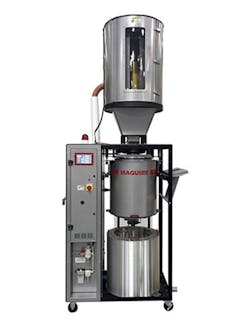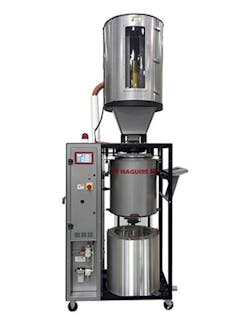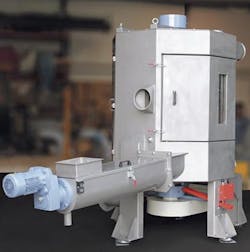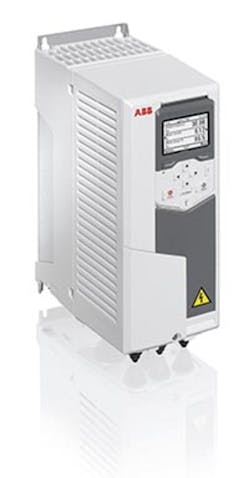Auxiliary equipment makers invest in energy-saving tech
In recent years, some of the businesses that relocated their operations overseas now are back in the States, having learned that the grass is not always greener on the other shore. While away, many of them learned that the money they saved through cheaper labor costs was subsequently lost due to an expensive and unreliable energy supply.
Because energy is so cheap here, some in the plastics industry believe that energy-saving technologies have little influence over auxiliary equipment purchasing decisions.
Taking a look at the most recent offerings from auxiliary equipment manufacturers, however, shows that there is a flaw in that reasoning. Many manufacturers have invested significant amounts of time and money to find ways to conserve energy and lower costs, and those decisions are being driven by customer demand, said Frank Kavanagh, VP of sales and marketing for Maguire Products.
"I agree that American companies, generally speaking, are less concerned with energy savings than their counterparts in Europe and Asia," he said. "But in certain parts of the country, particularly the Northeast and California, a reduction in energy consumption can be a significant advantage."
A reduction in energy costs is desirable, no matter where a processor is located, so equipment manufacturers are working to ensure their offerings are as efficient as possible.
Maguire Products
Maguire has upgraded its VBD line of dryers with new software that reduces energy consumption at lower throughputs. It is standard on all new models and available as a free upgrade to existing VBD units, which are available with throughputs of 150, 300 or 1,000 pounds of resin per hour. A new version with a throughput of 600 pounds per hour will be making its debut at NPE in April.
Because they are vacuum dryers, the VBD series was already stingy when it comes to drying time and energy consumption, finishing the job in about 80 percent less time than a traditional desiccant dryer, while consuming almost 60 percent less energy, Kavanagh said.
That's because desiccant material dries by absorbing moisture from the resin, but eventually the desiccant itself becomes saturated and must be regenerated before it can go back to work. Desiccant material must be replaced every so often as well, adding to the cost.
But there were limits to the advantages of the prior VBD model. Previously, VBD dryers typically were at their most efficient when operating at or near their full throughput capacity (unless a unit is specifically configured to operate at lower throughputs). As throughputs decreased, so did their efficiency.
Thanks to Maguire's new software, however, the VBD line "eliminates the penalty for low-throughput operation by using data acquired from previous heating cycles to make adjustments to the current cycle, ensuring that the absolute minimum amount of energy is used while achieving adequate and complete heating of the resin without operator intervention," Kavanagh said.For example, when operating at full capacity, the VBD 300 consumes about 46 watts per kilogram per hour when drying PC at 250 degrees Fahrenheit. The new software enables that same unit to dry 11 kilograms of resin per hour with about the same degree of energy efficiency, even though it's running at about 8 percent of capacity.
The new control also includes a standard on-board energy-consumption display, showing both real-time and time-averaged values in watts per kilogram per hour.
Herbold Meckesheim
Herbold Meckesheim's newest offering, the HVT series of centrifugal dryers, began shipping to customers in the summer. It features a new design in which material is conveyed vertically through the drying chamber rather than horizontally.
Designed for the recycling of regrind — especially hollow parts, PET bottles and polyolefins — the series consists of four models, with throughputs ranging from 1 ton to 8 tons per hour for hard plastics, and 0.8 ton to 8 tons for PET flake. The use of a vertical rotor shaft ensures a longer dwell time for the materials, and the design also saves space on the shop floor.
Processors using a typical one- or two-stage drying system would require a 150-horsepower (hp) motor to process 2.5 tons to 3 tons of material per hour. With its new design, however, the HVT series could handle a similar workload with just a 75-hp motor, providing a significant reduction in energy consumption.
The dryer has other benefits, as well, said David Lefrancois, president of Herbold USA. "Compared to older dryers, the HVT offers better yields based on reduced fines generation during the drying process, saving thousands of pounds of material annually that would have been discarded otherwise," he said. "The step design of our rotor — in lieu of the standard, straight-rotor design offered by most competitors — reduces the impact on the material, which creates fewer fines for materials that fracture on impact, such as PET."
ABB
The newest general-purpose low-voltage drive from ABB provides energy-efficient motor and process control for pumps, fans, conveyors, mixers and other types of auxiliary equipment. Swapping out the constant-speed drive for the new ACS580 variable-speed drive can reduce energy consumption by as much as 50 percent, said Greg Semrow, ABB's platform manager for low-power drives and automation.
"It also offers the ability to track the savings, in both energy and dollars, so users can evaluate the effectiveness of their systems, and adjust accordingly for even greater savings," he said.ABB's overarching goal is to help users achieve greater efficiency with all of their processes, Semrow explained. "When your processes run more efficiently, the result is not only energy savings; it also minimizes wear and tear on your mechanical equipment, which results in further financial savings," he said.
In addition to being more efficient, the drive:• allows users to manually fine-tune the speed of the conveyor,• synchronizes the motor control and mechanical brake control,• provides smooth acceleration and deceleration, and• protects the motor in stall situations.
The ACS580 is easy to install, commission, expand and upgrade, and the essential features such as Safe Torque Off are integrated into the unit. "That means there is less equipment to install, commission and maintain, which helps to contain overall system costs," Semrow said.
Michael T. McCue, copy editor
For more information
ABB Inc.,New Berlin, Wis., 262-785-3200, www.abb.us
Herbold Meckesheim USA,North Smithfield, R.I., 401-597-5500, www.herboldusa.com
Maguire Products Inc.,Aston, Pa., 610-459-4300, www.maguire.com



